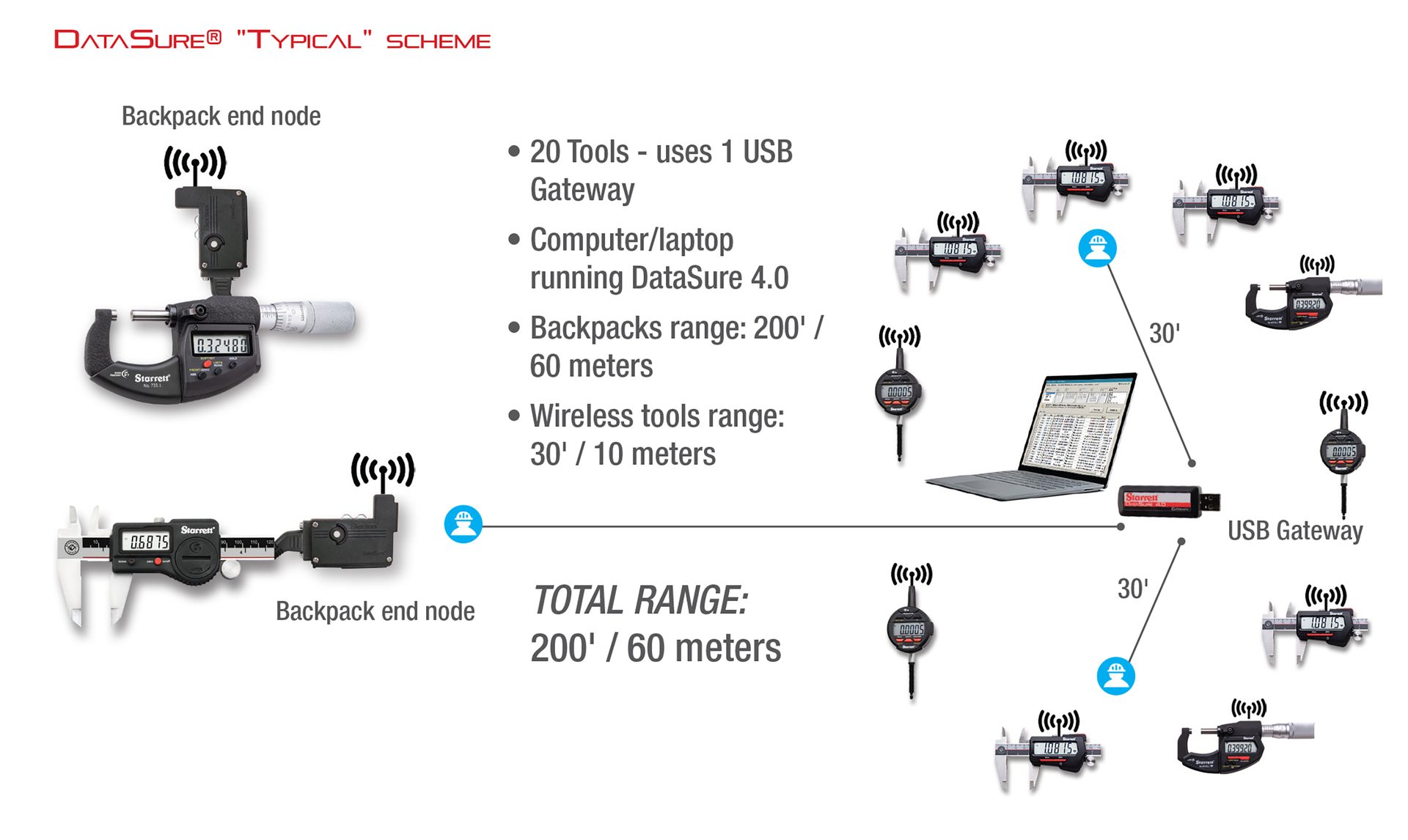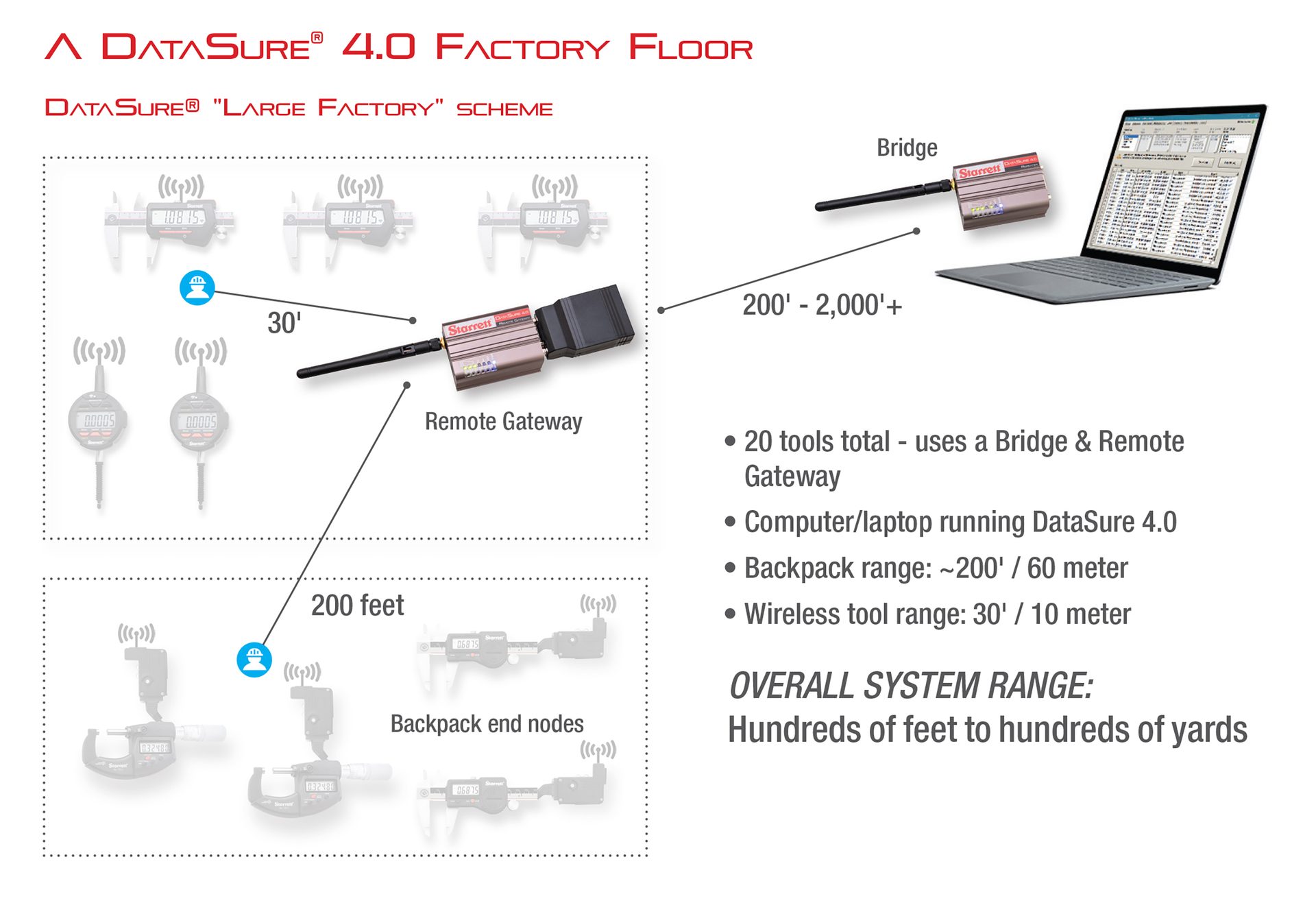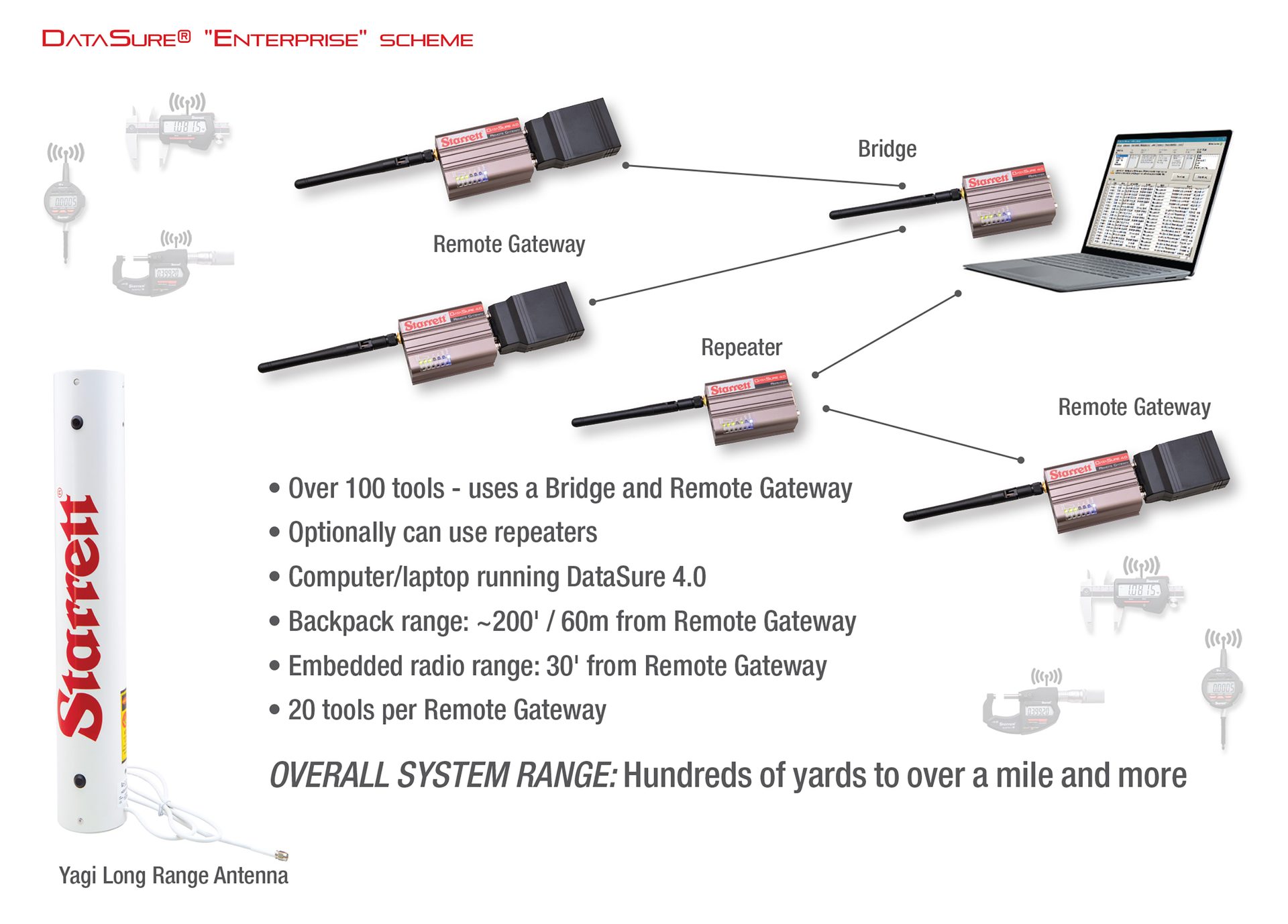Software & Analysis
Software & Analysis
The best wireless data collection systems can dramatically increase productivity, remove the potential for errors, provide complete documentation and automate the data acquisition process. By The L.S. Starrett Co.
Integrating QC Measurement Data into
Manufacturing Systems
The Internet of Things (IoT) and, in a broader sense, the Fourth Industrial Revolution (Industry 4.0) is the omnipresent new paradigm in manufacturing today, profoundly affecting the way manufacturers are operating or are planning to operate. Improving Overall Equipment Effectiveness (OEE) is a key new IoT requirement, and optimizing OEE necessitates accurate, up-to-date data across the entire organization, including measurement and test data collected from both quality labs and directly from the manufacturing floor.
Increasing the speed, volume and accuracy of measurement and inspection data collection is critical, as it provides powerful insights vital to improving efficiency and consistently manufacturing quality parts. In terms of acquiring/ collecting precision measurement data for quality control purposes, the clearest path to these advantages comes from wireless and mobile retrieval technology.
Wireless data collection systems should be mobile as well as robustly encrypted and secured, and be suitable for multiple needs ranging from unrestricted distances and gage compatibility, to ease of use and practical integration into automated manufacturing operations. The best wireless data collection systems can dramatically increase productivity, remove the potential for errors, provide complete documentation and automate the data acquisition process. Systems should include all of these benefits whether used by a single employee or across an entire company with an integrated quality control system.
Why traditional approaches to quality control measurement data leave too much room for error
There are many reasons why manufacturers need to collect accurate, timely and complete measurement and inspection data. OEE, Lean and Six Sigma initiatives require trustworthy data to support the best quality control practices. Manufacturers, especially those in industries such as medical, biomedical, aerospace and defense, must often meet regulatory requirements and provide traceable, reliable documentation for critical part manufacture.
Data collection systems of the past share common limitations, including:
- Potential for human error and delay: Systems that ask workers to manually track key measurements require extremely precise attention to detail, exercised many dozens or even hundreds of times in a single shift – all which is often difficult and unrealistic to consistently do, even if it is being done in the first place. Education is another issue — employees may not have the background needed to fully understand and accurately collect and transcribe data. Transposed digits, misplaced decimal points and similar issues can commonly occur. Additionally, an employee may need to halt production work to capture and record measurements, reducing overall productivity.
- Digital security issues: Unsecured networks that are used to transmit measurement data can provide inroads for hackers to gain more general access to a company’s data. When measurement data is transmitted without the proper digital security measures, it presents a potentially serious security risk.
- Lack of scalability: Business growth and diversification can necessitate more quality control processes which may be spread-out over one facility or multiple locations. At best, if a data collection system is not scalable, setting up separate data collection processes is time consuming, cumbersome and may lead to confusion, inaccuracies and delayed communication. Or even worse, product rejections, failures and legal implications with customers may result.
- Incomplete analysis through a sampling strategy: A sampling strategy simply cannot provide the complete picture offered by 100% measurement of each component produced. This structure, common with some traditional QC processes, may lead to an inability to predict and identify drifting production tolerances. In addition, this strategy is not even an option for industries such as medical or military that require 100% part inspection and traceable documentation.
- Increased possibility of rejects: Every rejected part represents money, time and resources lost. Without the full insight provided by 100% measurement, manufacturers risk incurring additional expenses as well as potentially harming relationships with customers. If a would-be rejected part makes its way to a customer, especially one that requires strict standards compliance, the results can have serious implications, if not catastrophic.
How the latest systems improve, modernize and streamline the collection of quality control measurement data
An underlying principle is to enable manufacturers to accurately and consistently acquire large amounts of measurement data for meeting Industry 4.0 requirements. Today’s wireless measuring data collection systems should be complete, scalable, secure and robust for Industry 4.0.
That means offering foundational benefits thorough automation, ease of operation, streamlined scalability, robust data encryption and protection, and unrestricted distances and unencumbered use for transmission. The result is increased productivity, reduced errors, provision of full documentation and a reliable data acquisition process driven by automation.
Operating on the latest wireless networking technology that uses short-wave radio frequencies to interconnect cell phones, computers and wireless electronic devices, this enables much faster speed, greater bandwidth and longer range for higher data throughput. Systems such as these offer a wide range of crucial benefits including:
Automation: When employees have to repeatedly stop work to record a measurement, productivity is surely negatively impacted. Also, manual data collection processes can introduce errors into the records database, with the potential to severely reduce accuracy and perpetuate flaws going forward. With the latest measuring data collection systems, the press of a button can transmit measurement data, significantly saving time. For example, it is at least four times faster to push a button compared with writing data and then typing it into a computer.
Automation is maximized throughout the quality control measurement data collection process, improving process efficiency and the accuracy of measurements captured. Features such as automatic time stamping provide critical context about each data point, required for traceability and compliance to quality control/ production specifications. Sending a message back to the measuring tool confirming receipt is also useful.
Speed: High data volumes can be processed without delay, even at full capacity, with systems that use higher bit rates and a very high-speed connection of less than 50ms of data travel time, as well as an ultra-low latency network.
Ease of operation: Establishing a measurement data collection process can be met with resistance on multiple levels. For company management, there may be uncertainty that putting a new method in place will have tangible benefits. For operators, there might be some fear of the unknown and trepidation when learning a new process. To assuage these concerns, ease of use is a high priority so that operators can quickly feel confident and the data collection process is optimized in a short period of time. For example, ease of operation extends to the mobile app, which eliminates the need to bring larger hardware, such as a laptop, into the field.
Versatility: A new network topology structure can be configured to many simple or complex situations and distributed remote gateways can also be utilized. The modular structure of today’s systems makes it simple to expand or contract a quality control measurement data collection process without having to acquire a new data collection system. Data is transmitted from gages that have either built-in radio transmitters or externally-mounted end nodes to gateways, and is operable on both Android or IOS mobile platforms and Windows® based computers including laptops, desktop PCs, thin client PCs, and servers. Repeater and bridge components can also connect directly to PLCs and other high-speed serial automation equipment for real-time data collection or remote machine operation.
For wireless measurement, it is extremely productive to use wireless measuring tools that include embedded radios, making them easier to use for data collection. It is also advantageous for a measuring data collection system to be compatible with a wide range of electronic precision tools and gages brands. Backpack radios expand functionality and are unobtrusive and easily attached. Users of the latest measuring data collection systems can utilize multiple gateways which serve as central or distributed points for data collection, versus conventional systems that have only one gateway. Compact gateways and repeaters can easily fit in the palm of a hand.
Additionally, applications for data collection are incredibly diverse, and the system should be versatile enough to cover all those applications. The latest measuring data collection systems are adaptable to nearly every use case, with examples ranging from automotive and agricultural, to 100% measurement of all parts and components in highly regulated industries such as defense, aerospace, medical, energy and more.
Scalability: The latest data collection systems are designed to dependably and accurately acquire precision measurement data in an extensive range of applications and distances. From just one or a few measuring tools over short distances, to configurations that have many measuring tools located hundreds of yards apart in a large factory or spread out over a mile in multiple facilities, expanded distances and increased application requirements are easily accommodated as measurement data collection requirements evolve and grow.
In its simplest application, a “Portable Scheme” features a Wireless app running on a mobile device. This straightforward setup can have one wireless measuring tool with an embedded radio transmitting data up to 30 feet (10 meters) to a mobile device. Or, dependent on the mobile device, a Portable Scheme may have 5-8 measuring tools that connect to the mobile app for data transmission up to 30 feet (10 meters). Also, users can easily transmit measurement data up to 30 feet (10 meters) from one (or more) Wireless Measuring Tool(s) to a laptop or PC that have a USB gateway.

Figure 1 – Portable Scheme
In a “Typical Scheme”, the manufacturer could have a computer or laptop running the measuring data collection system to support 20 measuring tools in the data collection process over a distance of up to 200 feet. In this setup, one USB gateway is included and backpack end nodes on the measuring tools increase the transmission range from 30 feet to 200 feet.

Figure 2 – Typical Scheme
In a “Large Factory Scheme” example, 20 measuring tools can use a bridge and remote gateway to expand the total data transmission range to hundreds of feet or yards.

Figure 3 – Large Factory Scheme
And in an “Enterprise Scheme”, measurement data transmission can be increased from hundreds of yards to over a mile. By using remote gateways, bridges and perhaps adding in repeaters, over 100 measuring tools can be incorporated. Each remote gateway can facilitate 20 measuring tools. For even greater distances, Yagi Long Range Antennas can be incorporated in the scheme.

Figure 4 – Enterprise Scheme
Robust data encryption and protection: Data security is top-of-mind for all manufacturers, including military. And while quality control measurement data by itself might not be particularly valuable to hackers, cybercriminals can still spoof the networks used to transmit quality control data to gain more general access to digital infrastructure.
Measuring data collection systems address this issue through a variety of measures, including security efforts which feature a highly secure wireless platform. Transported data is encrypted using a multi-layered approach that absolutely prevents any outside access to the data, whether passive or active.
In addition, the mobile app doesn’t connect to the OS of a smartphone or tablet, restricting unintended access at a critical point. Maintaining good security also includes addressing emerging vulnerabilities in radio transmission on a frequent basis to keep systems secure going forward, which your measuring data collection systems supplier should be dedicated to keeping pace with.
Unrestricted distances and unencumbered use for transmission: Leveraging remote gateways, bridges and repeaters offers an efficient and reliable data transmission framework. System structures can involve as few components as a backpack or embedded radio along with a mobile device running the mobile app, or utilize bridges, gateways and repeaters to greatly extend transmission ranges in a large factory configuration.
The latest measuring data collection systems’ software application uses a wireless network to gather information from multiple measuring tools. The wireless network relies on the measuring tools’ embedded wireless technology or end nodes to gather and then relay data back to the PC. The data collection system can also send signals out to the network components to verify transmissions and request data. The hardware components of the system are the: USB Gateway, Remote Gateway, Bridge Extenders, and End Node(s). The End Node is a radio transmitter/ receiver that gets attached to a measuring tool. The USB Gateway is a radio transmitter/ receiver attached to a PC. The Remote Gateway is the same as the USB Gateway but also extends the communication range from the PC, by using a Bridge extender to boost the signals between the Remote Gateway, and the PC. The Remote Gateway has the same range as the USB Gateway but can be set up very far away from the PC.
Regardless of the system architecture put into place, the result is a dependable, accurate and fast solution for gathering quality control measurement data from every point of operation where data collection is needed.
Practicality: It is efficient to use end nodes and wireless measuring tools that are rechargeable, eliminating battery replacement and associated costs. Also, consider using end nodes and wireless measuring tools that offer an IP67 level of protection for use in harsh shop environments. The ability to adapt to most existing SPC, MRP, and ERP programs is another advantage to the measuring data collection system.
Consider Other Technical Details & Capabilities
- Operating distance from gateways or mobile device is up to 30 feet (10 meters) for Wireless Measuring Tools
- Operating distance from gateways is up to 200 feet (61 meters) for backpack end nodes
- One Gateway system handles up to 20 measuring tools, primarily calipers, micrometers, and indicators
- Additional Remote Gateways will expand the number of measuring tools supported in increments of 20 each, and a repeater can increase the transmission range to miles
- End Node Radios can store up to 10 readings if the main system is down or busy
- Broadcast range is up to 2,000 feet (610 meters) between Remote Gateways and Bridge
- Virtual multiplexers provided in the measuring data collection system take many inputs (tool data) and share them over a single output resource, which is a virtual COM port. The virtual multiplexer takes tool data and sends them on to a COM port for SPC software and other SW packages to process.
- Remote access over a LAN to the data collection server via remote client software
- Optional antenna types for various deployments
Suppler knowledge, service and support is key when choosing a measuring wireless data collection system. A deep level of experience combined with expertise in quality control will go far in establishing a successful implementation.
